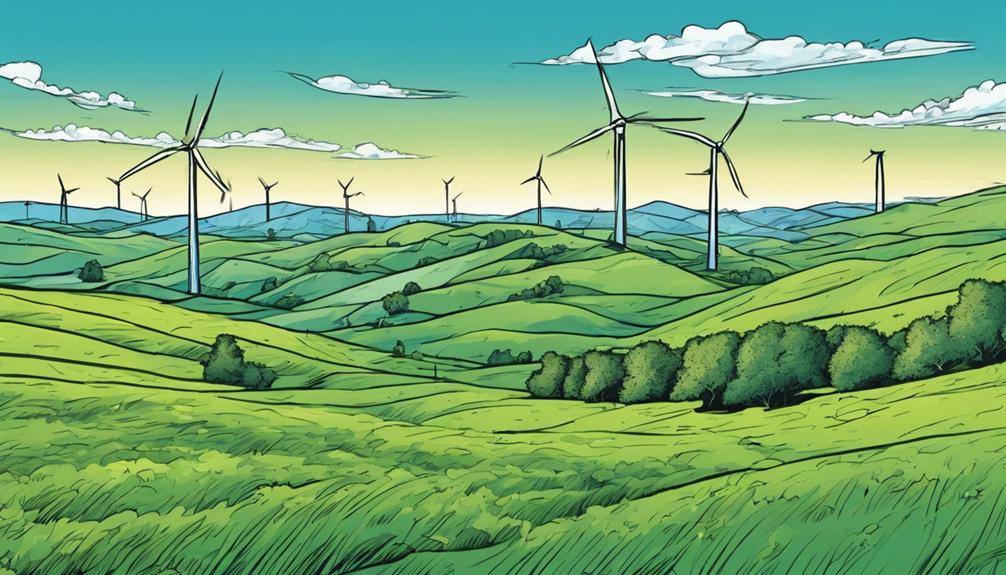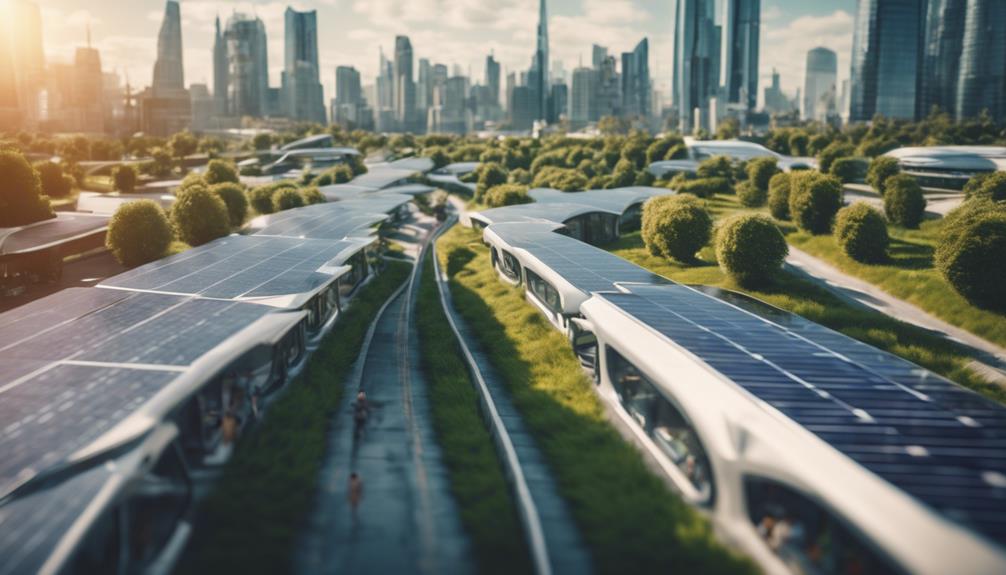As the world shifts towards sustainable energy solutions, highways are increasingly embracing wind turbines as a clean and efficient way to generate electricity. With the United States, Europe, and Asia leading the charge, this innovative approach to renewable energy is gaining popularity. Wind turbines offer a durable, low-maintenance, and cost-effective solution to traditional energy sources, reducing emissions and generating income. While safety risks and visual impacts are being addressed, the benefits of wind turbines on highways are undeniable. As the adoption of wind turbines continues to grow, it's clear that the future of energy production is looking brighter – and cleaner.
Key Takeaways
- Wind turbines on highways reduce emissions, create jobs, and improve infrastructure, making them a sustainable energy solution for transportation.
- These eco-friendly structures require less land compared to other energy sources and are durable, low-maintenance, and cost-effective.
- Proper placement, design, and maintenance are crucial for balancing energy production benefits with addressing safety risks for motorists and residents.
- Wind turbines on highways stimulate local economies, generate clean energy, and reduce reliance on fossil fuels, decreasing emissions and improving air quality.
- Global adoption is increasing, with the US, Europe, and Asia embracing wind turbines to meet growing electricity demand and reduce environmental impacts.
Wind Turbines on Highways Overview

Wind turbines, innovative renewable energy sources, are reshaping the transportation sector by converting wind into electricity along highways globally. These eco-friendly structures consist of propeller-like blades attached to tall towers, offering a sustainable solution to traditional energy sources.
Noteworthily, wind turbines are durable, require low maintenance, and are cost-effective, making them an attractive option for countries seeking to reduce their carbon footprint. Strategically located in areas with strong winds, these turbines maximize energy production while minimizing environmental impact.
As the world shifts towards a greener future, wind turbines on highways are poised to play a crucial role in the shift to renewable energy.
Benefits and Drawbacks Comparison

While wind turbines on highways offer a promising solution to the world's energy needs, they also come with a mix of benefits and drawbacks that must be carefully weighed. On the plus side, they reduce emissions, create jobs, and improve infrastructure. They also generate income, reduce noise and air pollution, and require less land.
However, they can be noisy, visually impactful, and pose safety risks. To mitigate these drawbacks, measures like sound-dampening materials and safety protocols are implemented. As the world moves towards sustainable energy, striking a balance between the benefits of wind turbines and their potential drawbacks is crucial, ensuring a greener future without compromising on safety and convenience.
Safety Risks and Current Status

Their placement along highways poses physical and psychological safety risks to motorists and nearby residents, including disruption of air currents and visual disruption that can impact driver attention and reaction times.
Ongoing wind turbine projects on highways focus on balancing energy production benefits with addressing these drawbacks. Experts emphasize the importance of thorough research, consultation, and planning to mitigate safety risks.
Proper placement, design, and maintenance of wind turbines are essential to ensuring the safety of road users. As the demand for renewable energy grows, careful consideration and planning are vital for the success of wind turbine projects on highways.
Global Perspectives on Adoption

Across the globe, diverse regions are embracing wind turbines on highways, driven by varying motivations and facing distinct challenges in their adoption.
In the United States, wind turbines are gaining popularity, backed by government subsidies and public support.
Europe is experiencing a renewable energy revolution, with minimal environmental impact.
In Asia, countries are exploring wind turbines to meet their growing electricity demand.
Regulatory challenges persist, including environmental reviews, noise pollution, and energy efficiency.
Despite these hurdles, innovations in design focus on efficiency, cost savings, and sustainability.
As the world moves towards sustainable transportation and energy production, wind turbines on highways are becoming an integral part of the solution.
Economic and Environmental Impact

Wind turbines on highways are proving to be a boon for local economies, generating clean energy, creating jobs, and stimulating economic growth. By harnessing wind power, these turbines reduce reliance on fossil fuels, decreasing emissions and improving air quality. This shift towards sustainable energy production has a positive impact on the environment, contributing to a greener future.
- Reduced infrastructure costs
- Long-term economic benefits
- Increased economic competitiveness
- Minimal environmental impacts
Frequently Asked Questions
What Happens to Birds Flying Near Wind Turbines on Highways?
Birds flying near wind turbines on highways face collision risks, particularly birds of prey and migratory species, although turbine design advancements and careful placement minimize fatalities, ensuring a balance between energy production and wildlife conservation.
Can Wind Turbines on Highways Interfere With Radio Signals?
Wind turbines on highways can potentially interfere with radio signals due to their tall structures and rotating blades, which can cause signal disruption or scattering, affecting radio communication quality and reliability.
How Do Wind Turbines on Highways Affect Property Values Nearby?
Wind turbines on highways can have a "gentle" impact on nearby property values, as some residents appreciate the eco-friendly appeal, while others might view them as visually unappealing, affecting resale value.
Are Wind Turbines on Highways Insured Against Natural Disasters?
Wind turbines on highways are typically covered against natural disasters, such as hurricanes or earthquakes, to mitigate financial losses and maintain continuous energy production, with insurance policies covering damage and business interruption.
Can Wind Turbines on Highways Be Used for Electric Vehicle Charging?
Yes, wind turbines on highways can be used for electric vehicle charging, providing a sustainable energy source for EVs and reducing dependence on fossil fuels, while also promoting eco-friendly transportation solutions.
How Effective are Wind Turbines on Highways for Generating Energy?
wind turbine energy harnessing.on highways has shown promising results in generating sustainable energy. With the constant flow of wind, the turbines can efficiently produce electricity to power nearby areas. It’s an innovative approach to utilizing natural resources and reducing our reliance on non-renewable energy sources.
Conclusion
As the world accelerates towards a sustainable future, wind turbines on highways are emerging as a game-changer. With over 10,000 turbines already installed globally, it's estimated that if just 1% of the world's highways were equipped with wind turbines, they could power over 20 million homes.
This innovative approach is poised to revolutionize the transportation sector, slashing emissions and creating a cleaner, greener tomorrow.










